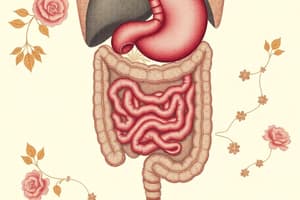Podcast
Questions and Answers
What is the primary characteristic of irritable bowel syndrome (IBS)?
What is the primary characteristic of irritable bowel syndrome (IBS)?
- Damage to the small intestine due to gluten
- Formation of solid crystalline masses in the gallbladder
- Chronic inflammation of the digestive tract
- Abdominal pain, bloating, and changes in bowel habits (correct)
Which condition is classified as an autoimmune disorder?
Which condition is classified as an autoimmune disorder?
- Gallstones
- Irritable bowel syndrome
- Celiac disease (correct)
- Diverticulitis
What does mechanical digestion primarily involve?
What does mechanical digestion primarily involve?
- Breaking food down into simpler molecules using enzymes
- Physical breakdown of food into smaller pieces (correct)
- Absorbing nutrients into the bloodstream
- Removing undigested material from the body
Inflammatory bowel disease (IBD) includes which of the following?
Inflammatory bowel disease (IBD) includes which of the following?
Absorption in the digestive process refers to what action?
Absorption in the digestive process refers to what action?
What is the primary function of saliva in the mouth?
What is the primary function of saliva in the mouth?
What role do the villi and microvilli play in the small intestine?
What role do the villi and microvilli play in the small intestine?
Which of the following organs produces bile necessary for fat digestion?
Which of the following organs produces bile necessary for fat digestion?
What mechanism moves food through the esophagus to the stomach?
What mechanism moves food through the esophagus to the stomach?
What is the main purpose of gastric juices in the stomach?
What is the main purpose of gastric juices in the stomach?
Which section of the small intestine is primarily responsible for receiving secretions from the pancreas and liver?
Which section of the small intestine is primarily responsible for receiving secretions from the pancreas and liver?
What is the function of beneficial bacteria in the large intestine?
What is the function of beneficial bacteria in the large intestine?
Heartburn is primarily caused by which of the following?
Heartburn is primarily caused by which of the following?
Flashcards
IBS
IBS
Chronic disorder causing abdominal pain, bloating, and changes in bowel habits.
IBD
IBD
Includes Crohn's and ulcerative colitis, causing inflammation in the digestive tract.
Diverticulitis
Diverticulitis
Inflammation of small pouches in the digestive tract.
Celiac Disease
Celiac Disease
Signup and view all the flashcards
Mechanical Digestion
Mechanical Digestion
Signup and view all the flashcards
Mouth Digestion
Mouth Digestion
Signup and view all the flashcards
Esophagus Function
Esophagus Function
Signup and view all the flashcards
Stomach Digestion
Stomach Digestion
Signup and view all the flashcards
Small Intestine Absorption
Small Intestine Absorption
Signup and view all the flashcards
Large Intestine Function
Large Intestine Function
Signup and view all the flashcards
Liver Function
Liver Function
Signup and view all the flashcards
Pancreas in Digestion
Pancreas in Digestion
Signup and view all the flashcards
Chyme
Chyme
Signup and view all the flashcards
Study Notes
Overview
- The digestive system is a complex network of organs working together to break down food into absorbable nutrients, providing the body with energy and building blocks for cells.
- It involves both mechanical and chemical processes.
- Key players include the mouth, esophagus, stomach, small intestine, large intestine, and accessory organs like the liver, pancreas, and gallbladder.
Mouth
- Mechanical digestion begins in the mouth with chewing (mastication).
- Saliva, containing enzymes like amylase, initiates chemical digestion, breaking down carbohydrates.
- Tongue shapes food into a bolus for swallowing.
Esophagus
- Muscular tube connecting the mouth to the stomach.
- Peristalsis, wave-like muscle contractions, moves food through the esophagus.
- Epiglottis prevents food from entering the trachea (windpipe).
Stomach
- J-shaped organ that stores and partially digests food.
- Muscular contractions churn the food (mechanical digestion).
- Gastric glands secrete gastric juice, containing hydrochloric acid (HCl) and enzymes like pepsin, initiating protein digestion.
- Mucus protects the stomach lining from acid.
Small Intestine
- Long, coiled tube where most nutrient absorption occurs.
- Divided into three sections: duodenum, jejunum, and ileum.
- Duodenum receives secretions from the pancreas and liver, which further digest proteins, carbohydrates, and fats.
- Enzymes like maltase, sucrase, and lactase break down further carbohydrates.
- Villi and microvilli increase the surface area for absorption.
- Nutrients are absorbed into the bloodstream.
Large Intestine
- Wider and shorter than the small intestine.
- Absorbs water and electrolytes from undigested food.
- Houses beneficial bacteria that aid in further digestion and vitamin production.
- Forms and stores feces.
- Processes undigested material into feces.
Accessory Organs
- Liver: produces bile, crucial for fat digestion and absorption.
- Gallbladder: stores and concentrates bile.
- Pancreas: produces numerous digestive enzymes and bicarbonate to neutralize stomach acid.
- Pancreatic enzymes break down carbohydrates, proteins, and fats.
- Bicarbonate neutralizes the acidic chyme (partially digested food from stomach) entering the small intestine.
Disorders and Problems
- Heartburn: burning sensation in the esophagus due to acid reflux.
- Peptic ulcers: sores in the lining of the stomach or duodenum caused by bacteria (H. pylori) or excessive acid production.
- Irritable bowel syndrome (IBS): chronic disorder causing abdominal pain, bloating, and changes in bowel habits.
- Inflammatory bowel disease (IBD): includes Crohn's disease and ulcerative colitis, causing inflammation in the digestive tract.
- Diverticulitis: inflammation of small pouches in the digestive tract.
- Celiac disease: an autoimmune disorder triggered by gluten consumption, leading to damage in the small intestine.
- Gallstones: solid crystalline masses formed in the gallbladder.
Digestive Processes
- Mechanical digestion involves physical breakdown of food.
- Chemical digestion uses enzymes to break down food into simpler molecules.
- Absorption is the process of moving nutrients from the digestive tract into the bloodstream.
- Elimination is the removal of undigested material from the body.
Studying That Suits You
Use AI to generate personalized quizzes and flashcards to suit your learning preferences.



